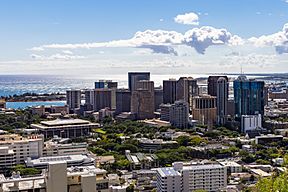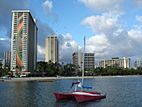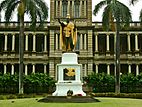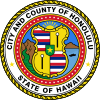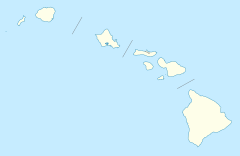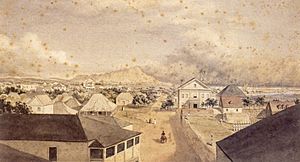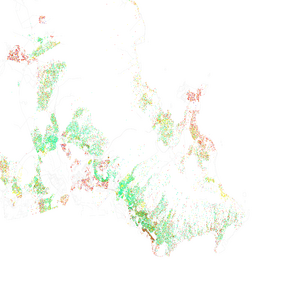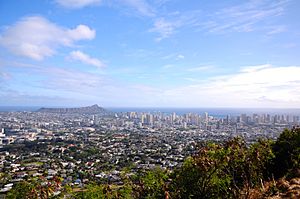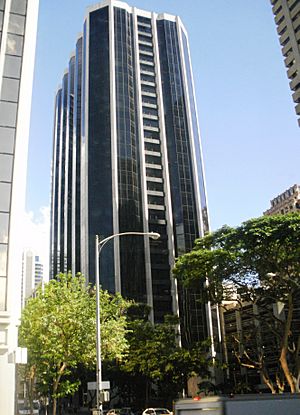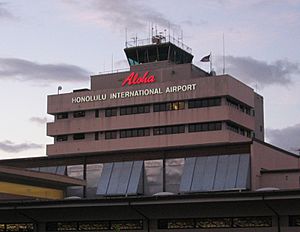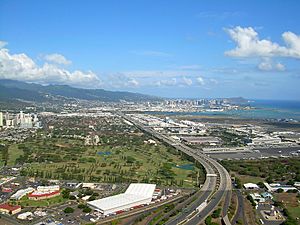Honolulu facts for kids
Quick facts for kids
Honolulu
|
|||
|---|---|---|---|
| City and County of Honolulu | |||
|
Waterfront on Waikiki Beach
Statue of King Kamehameha I in front of Aliʻiōlani Hale downtown
|
|||
|
|||
| Nicknames:
Crossroads of the Pacific, Sheltered Bay, HNL, The Big Pineapple, Paradise
|
|||
| Motto(s):
Haʻaheo No ʻO Honolulu (The Pride of Honolulu)
|
|||
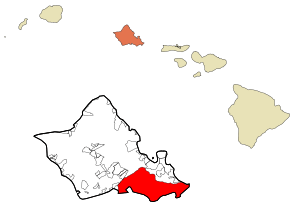
Urban Honolulu and East Honolulu CDPs (combined) in Honolulu County and the state of Hawaii
|
|||
| Country | United States | ||
| State | Hawaii | ||
| County | Honolulu | ||
| Incorporated | April 30, 1907 | ||
| Area | |||
| • City | 68.4 sq mi (177.2 km2) | ||
| • Land | 60.5 sq mi (156.7 km2) | ||
| • Water | 7.9 sq mi (20.5 km2) | ||
| • Urban | 145.0 sq mi (375.5 km2) | ||
| Elevation | 16 ft (5 m) | ||
| Population
(2020)
|
|||
| • City | 350,964 (US: 55th) | ||
| • Density | 5,791/sq mi (2,236.1/km2) | ||
| • Urban | 853,252 (US: 54th) | ||
| • Urban density | 5,885/sq mi (2,272.4/km2) | ||
| • Metro | 1,016,508 (US: 55th) | ||
| Demonym(s) | Honolulan | ||
| GDP | |||
| • Metro | $81.676 billion (2023) | ||
| Time zone | UTC−10:00 (Hawaiian (HST)) | ||
| ZIP Codes |
96801–96826, 96828, 96830, 96836-96841, 96843-96844, 96846-96850
|
||
| Area code(s) | 808 | ||
| FIPS code | 15-17000 | ||
| GNIS feature ID | 366212 | ||
Honolulu (![]() i/ˌhɒnəˈluːluː/ HON-ə-LOO-loo) is the capital city of Hawaii, a U.S. state in the Pacific Ocean. It is the largest city in Hawaii. Honolulu is located on the southeast coast of Oʻahu island. It is the westernmost and southernmost major city in the United States.
i/ˌhɒnəˈluːluː/ HON-ə-LOO-loo) is the capital city of Hawaii, a U.S. state in the Pacific Ocean. It is the largest city in Hawaii. Honolulu is located on the southeast coast of Oʻahu island. It is the westernmost and southernmost major city in the United States.
Honolulu is Hawaii's main connection to the rest of the world. It is also a big center for business, money, tourism, and military defense. The city has a mix of Asian, Western, and Pacific cultures. This mix can be seen in its people, food, and traditions.
The name Honolulu means "sheltered harbor" or "calm port" in the Hawaiian language. Its old name, Kou, covered the area that is now downtown. The city's good harbor helped it grow and become important in the Hawaiian Islands. Honolulu has been the capital of the Hawaiian Islands since 1845. First, it was the capital of the independent Hawaiian Kingdom. Later, after 1898, it became the capital of the U.S. territory and then the state of Hawaii.
The city became famous worldwide after the Empire of Japan attacked Pearl Harbor on December 7, 1941. This attack caused the U.S. to join World War II. Pearl Harbor is still a major U.S. Navy base today. It is home to the United States Pacific Fleet, which is the world's largest naval command.
The U.S. Census Bureau calls the main area of Honolulu the "Urban Honolulu census-designated place." In 2020, Honolulu had 350,964 people. The larger Urban Honolulu Metropolitan Area had 1,016,508 residents in 2020. Honolulu is the most populated city in Oceania outside of Australasia.
Honolulu's warm climate, beautiful nature, and long beaches make it a popular place for tourists. In 2022, over 711,000 people visited Honolulu. This makes it one of the most visited cities in the United States.
Contents
- Exploring Honolulu's Past
- Honolulu's Location and Features
- Honolulu's Weather and Climate
- Who Lives in Honolulu?
- Honolulu's Economy and Jobs
- Culture and Fun in Honolulu
- Sports and Recreation
- Learning and Research in Honolulu
- Getting Around Honolulu
- Sister Cities Around the World
- Images for kids
- See also
Exploring Honolulu's Past
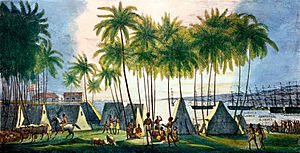
Port of Honolulu in 1816, painted by Louis Choris.
|
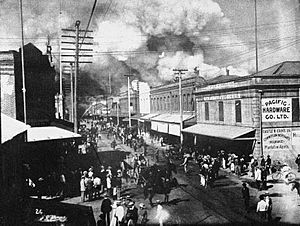
The Great Chinatown Fire of 1900.
|
People first settled in Honolulu around the 11th century. These were the original Polynesian travelers to the islands. We know this from old stories and things found from that time. After Kamehameha I won the [[Battle of Nuʻuanu]] on Oʻahu, he moved his royal court to Waikiki in 1804. His court then moved to what is now downtown Honolulu in 1809. The capital moved back to Kailua-Kona in 1812.
In November 1794, Captain William Brown was the first foreigner to sail into what is now Honolulu Harbor. More foreign ships came after him. This made Honolulu's port a key stop for merchant ships traveling between North America and Asia. The small settlement grew into a city in the early 1800s. This happened after Kamehameha I chose it as his home in 1810.
In 1845, Kamehameha III made Honolulu the permanent capital of the Hawaiian Kingdom. He and the kings after him built many modern buildings. These included St. Andrew's Cathedral, [[ʻIolani Palace]], and [[Aliʻiōlani Hale]]. At the same time, Honolulu became the center for business on the islands. Families of American missionaries started big businesses downtown.
The late 1800s and early 1900s were a tough time. The Hawaiian monarchy was overthrown in 1893. Hawaii was taken over by the U.S. in 1898. There was a big fire in 1900. And the Japanese attack on Pearl Harbor happened in 1941. Despite all this, Honolulu stayed the capital, largest city, and main airport and seaport of the Hawaiian Islands.
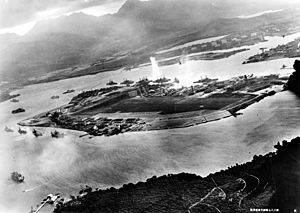
After Hawaii became a state, there was a big boom in its economy and tourism. This brought fast growth to Honolulu and Hawaii. Modern air travel brings millions of visitors to the islands each year. Most of them arrive at Honolulu International Airport. Today, Honolulu is a modern city with many tall buildings. Waikiki is the main area for tourism in Hawaii, with thousands of hotel rooms.
Honolulu's Location and Features
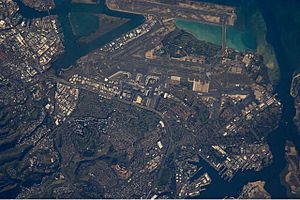
The Urban Honolulu area covers about 177.2 square kilometers (68.4 square miles). About 20.5 square kilometers (7.9 square miles) of this is water.
Honolulu is the major U.S. city farthest away from the mainland. It is also one of the most remote cities in the world. The closest point in the mainland U.S. is in northern California. That's about 2,045 nautical miles (3,787 km) away. The closest major city is San Francisco, California, at 2,397 miles (3,858 km).
The city sits partly on the Honolulu Volcanics. These are old volcanic areas.
Exploring Honolulu's Neighborhoods
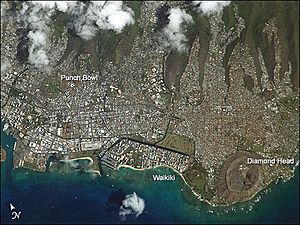
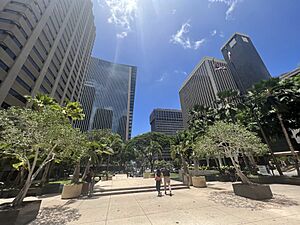
- Downtown Honolulu is the center for money, business, and government in Hawaii. The Aloha Tower is on the waterfront. For many years, it was Hawaii's tallest building. Now, the tallest building is the First Hawaiian Center. It is 438 feet (133 meters) tall. The downtown campus of Hawaiʻi Pacific University is also here.
- The Arts District Honolulu is on the east side of Chinatown. It is a 12-block area with many art and cultural places. It is inside the Chinatown Historic District.
- The Capitol District is the eastern part of Downtown Honolulu. It is the historic center of Hawaii's state government. Here you will find the State Capitol, [[ʻIolani Palace]], Honolulu Hale (City Hall), the State Library, and the statue of King Kamehameha I.
- Kakaʻako is an area between Downtown and Waikiki. It has been redeveloped a lot recently. It has two main shopping areas: Ward Warehouse and Ward Center. The John A. Burns School of Medicine is also here.
- Ala Moana is between Kakaʻako and Waikiki. It is home to Ala Moana Center. This is a very large outdoor shopping center and Hawaii's biggest mall. It has over 300 stores. Ala Moana Beach Park is also in this area.
- Waikiki is Honolulu's main tourist area. It is located between the Ala Wai Canal and the Pacific Ocean, next to Diamond Head. Many hotels, shops, and nightlife spots are here. Millions of visitors come to Waikiki every year.
- Mānoa, Mōʻiliʻili, and Makiki are neighborhoods just inland from downtown and Waikiki. The main campus of the University of Hawaiʻi is in Mānoa Valley.
- Nuʻuanu and Pauoa are residential areas inland from downtown Honolulu. The National Memorial Cemetery of the Pacific is in Punchbowl Crater.
- Pālolo and Kaimukī are neighborhoods east of Mānoa and Makiki. Pālolo Valley is a residential area. Kaimukī is mostly residential with shops along Waiʻalae Avenue. Chaminade University is in Kaimukī.
- Waiʻalae and Kāhala are wealthy areas directly east of Diamond Head. They have many expensive homes. The Waialae Country Club and the five-star Kahala Hotel & Resort are here.
- East Honolulu includes communities like ʻĀina Haina, Niu Valley, and Hawaiʻi Kai. These are considered upper-middle-class neighborhoods.
- Kalihi and Pālama are working-class neighborhoods. Lower Kalihi, near the ocean, is an industrial area.
- Salt Lake and Āliamanu are residential areas built in old tuff cones. They are near Honolulu International Airport.
- Moanalua is two neighborhoods and a valley at the western end of Honolulu. It is home to Tripler Army Medical Center.
Honolulu's Weather and Climate
Honolulu has a hot semi-arid climate. This means it has mostly dry summers. This is because of a rain shadow effect. Even though it's warm enough to be tropical, it doesn't get enough rain to be called tropical.
Temperatures don't change much all year. Highs are usually between 80–90°F (27–32°C). Lows are usually between 65–75°F (18–24°C). The "winter" months (December to March) can sometimes have lows below 64°F (18°C). The "summer" months (June to September) can have a few hot days over 90°F (32°C). This happens about 32 days a year on average. The highest temperature ever recorded was 95°F (35°C). The lowest was 52°F (11°C).
The city gets about 16.41 inches (417 mm) of rain each year. Most of this rain falls from October to early April. There is very little rain in the summer. However, both seasons have a similar number of rainy days. Summer has light showers, while winter has heavier rain. Honolulu has about 278 sunny days and 89 rainy days per year.
Even though Honolulu is in the tropics, hurricanes are very rare. The last big hurricane near Honolulu was Hurricane Iniki in 1992. Tornadoes are also uncommon, happening about every 15 years. Waterspouts off the coast are also rare, happening about every five years.
The average ocean temperature is about 75.7°F (24.3°C) in March. It rises to about 80.4°F (26.9°C) in September.
| Climate data for Honolulu International Airport (1981−2010 normals, extremes 1877−present ) | |||||||||||||
|---|---|---|---|---|---|---|---|---|---|---|---|---|---|
| Month | Jan | Feb | Mar | Apr | May | Jun | Jul | Aug | Sep | Oct | Nov | Dec | Year |
| Record high °F (°C) | 88 (31) |
88 (31) |
89 (32) |
91 (33) |
93 (34) |
92 (33) |
94 (34) |
93 (34) |
95 (35) |
94 (34) |
93 (34) |
89 (32) |
95 (35) |
| Mean maximum °F (°C) | 84.3 (29.1) |
84.4 (29.1) |
85.4 (29.7) |
86.6 (30.3) |
88.7 (31.5) |
89.5 (31.9) |
90.7 (32.6) |
91.3 (32.9) |
91.7 (33.2) |
90.5 (32.5) |
87.6 (30.9) |
85.2 (29.6) |
92.1 (33.4) |
| Mean daily maximum °F (°C) | 80.1 (26.7) |
80.2 (26.8) |
81.2 (27.3) |
82.7 (28.2) |
84.6 (29.2) |
87.0 (30.6) |
87.9 (31.1) |
88.7 (31.5) |
88.6 (31.4) |
86.7 (30.4) |
83.9 (28.8) |
81.2 (27.3) |
84.4 (29.1) |
| Daily mean °F (°C) | 73.2 (22.9) |
73.1 (22.8) |
74.5 (23.6) |
76.1 (24.5) |
77.8 (25.4) |
80.2 (26.8) |
81.2 (27.3) |
81.9 (27.7) |
81.5 (27.5) |
80.0 (26.7) |
77.6 (25.3) |
74.8 (23.8) |
77.7 (25.4) |
| Mean daily minimum °F (°C) | 66.3 (19.1) |
66.1 (18.9) |
67.7 (19.8) |
69.4 (20.8) |
70.9 (21.6) |
73.4 (23.0) |
74.5 (23.6) |
75.1 (23.9) |
74.4 (23.6) |
73.4 (23.0) |
71.4 (21.9) |
68.3 (20.2) |
70.9 (21.6) |
| Mean minimum °F (°C) | 59.3 (15.2) |
58.6 (14.8) |
61.2 (16.2) |
64.2 (17.9) |
65.3 (18.5) |
69.6 (20.9) |
70.8 (21.6) |
70.8 (21.6) |
70.1 (21.2) |
68.1 (20.1) |
65.4 (18.6) |
61.1 (16.2) |
57.0 (13.9) |
| Record low °F (°C) | 52 (11) |
52 (11) |
53 (12) |
56 (13) |
60 (16) |
63 (17) |
63 (17) |
63 (17) |
65 (18) |
61 (16) |
57 (14) |
54 (12) |
52 (11) |
| Average rainfall inches (mm) | 2.31 (59) |
1.99 (51) |
2.02 (51) |
0.63 (16) |
0.62 (16) |
0.26 (6.6) |
0.51 (13) |
0.56 (14) |
0.70 (18) |
1.84 (47) |
2.42 (61) |
3.24 (82) |
17.10 (434) |
| Average rainy days (≥ 0.01 inch) | 8.5 | 7.4 | 8.8 | 7.5 | 5.8 | 5.7 | 7.1 | 5.6 | 6.9 | 7.6 | 8.8 | 9.7 | 89.4 |
| Average relative humidity (%) | 73.3 | 70.8 | 68.8 | 67.3 | 66.1 | 64.4 | 64.6 | 64.1 | 65.5 | 67.5 | 70.4 | 72.4 | 67.9 |
| Mean monthly sunshine hours | 213.5 | 212.7 | 259.2 | 251.8 | 280.6 | 286.1 | 306.2 | 303.1 | 278.8 | 244.0 | 200.4 | 199.5 | 3,035.9 |
| Percent possible sunshine | 63 | 66 | 69 | 66 | 69 | 71 | 74 | 76 | 76 | 68 | 60 | 59 | 68 |
| Source: NOAA (relative humidity and sun 1961–1990) | |||||||||||||
| Climate data for Honolulu | |||||||||||||
|---|---|---|---|---|---|---|---|---|---|---|---|---|---|
| Month | Jan | Feb | Mar | Apr | May | Jun | Jul | Aug | Sep | Oct | Nov | Dec | Year |
| Average sea temperature °F (°C) | 76.5 (24.7) |
75.9 (24.4) |
75.7 (24.3) |
76.9 (25.0) |
77.9 (25.5) |
78.7 (25.9) |
78.9 (26.0) |
79.5 (26.4) |
80.4 (26.9) |
79.8 (26.5) |
78.5 (25.9) |
77.0 (25.0) |
78.0 (25.5) |
| Mean daily daylight hours | 11.0 | 11.0 | 12.0 | 13.0 | 13.0 | 13.0 | 13.0 | 13.0 | 12.0 | 12.0 | 11.0 | 11.0 | 12.1 |
| Average Ultraviolet index | 7 | 9 | 11 | 11 | 11 | 11+ | 11+ | 11+ | 11 | 9 | 7 | 6 | 9.6 |
| Source #1: seatemperature.org | |||||||||||||
| Source #2: Weather Atlas | |||||||||||||
Who Lives in Honolulu?
| Historical population | |||
|---|---|---|---|
| Census | Pop. | %± | |
| 1890 | 22,907 | — | |
| 1900 | 39,306 | 71.6% | |
| 1910 | 52,183 | 32.8% | |
| 1920 | 83,327 | 59.7% | |
| 1930 | 137,582 | 65.1% | |
| 1940 | 179,326 | 30.3% | |
| 1950 | 248,034 | 38.3% | |
| 1960 | 294,194 | 18.6% | |
| 1970 | 324,871 | 10.4% | |
| 1980 | 365,048 | 12.4% | |
| 1990 | 365,272 | 0.1% | |
| 2000 | 371,657 | 1.7% | |
| 2010 | 337,256 | −9.3% | |
| 2020 | 350,964 | 4.1% | |
| Population 1890–2010. | |||
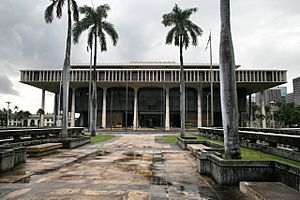
Population and Diversity
In 2020, Honolulu had 350,964 people. This makes it the 55th largest city in the U.S. The population was 337,256 in 2010.
The neighborhood of East Honolulu is often seen as part of Honolulu's main urban area. Its population was 50,922 in 2020. This brings Honolulu's core population to over 400,000.
Honolulu has a very diverse population. About 54.8% of people are Asian. About 17.9% are White. About 1.5% are Black or African American. About 8.4% are Native Hawaiian and other Pacific Islanders. Many people are also of two or more races. About 6.26% of the population is Hispanic or Latino.
Asian Americans make up the largest group in Honolulu. This includes people of Japanese (19.9%), Filipino (13.2%), and Chinese (10.4%) backgrounds.
The metropolitan area of Honolulu covers all of Oahu island. In 2020, it had 1,016,508 people. This makes it the 54th largest metropolitan area in the United States.
Honolulu's Economy and Jobs
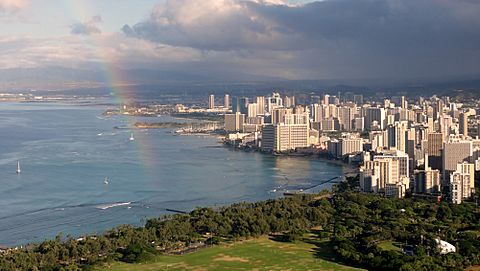
Honolulu is the biggest city and airport in Hawaii. It is a natural entry point for the islands' large tourism industry. Tourism brings millions of visitors and adds about $10 billion to the local economy each year. Honolulu's location in the Pacific also makes it a big center for business and trade. This is especially true for trade between the East and West. Other important parts of the city's economy include military defense, research, and manufacturing.
Some companies based in Honolulu include:
- Alexander & Baldwin
- Bank of Hawaii
- Central Pacific Bank
- First Hawaiian Bank
- Hawaii Medical Service Association
- Hawaii Pacific Health
- Hawaiian Electric Industries
- Matson Navigation Company
- The Queen's Health Systems
Hawaiian Airlines and Aloha Air Cargo have their main offices in Honolulu.
In 2009, Honolulu's average rent went up by 4.5%. This made it the second most expensive rental market among 210 U.S. cities. The cost of living, including gas, electricity, and most food, is much higher than in mainland U.S. This is because the city and state have to import most goods. A 2014 report found that living costs were 69% higher than the U.S. average.
First Hawaiian Bank is Hawaii's largest and oldest bank. Its headquarters are in the First Hawaiian Center. This is the tallest office building in the state.
Culture and Fun in Honolulu
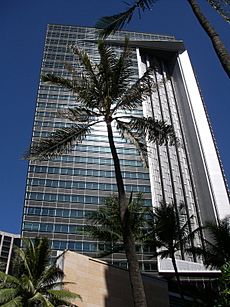
Museums and Nature Spots
The Bishop Museum is Honolulu's largest museum. It has the biggest collection of natural history items in Hawaii. It also has the world's largest collection of Hawaiian and Pacific culture artifacts. The Honolulu Zoo is Hawaii's main zoo. The Waikiki Aquarium is a working marine biology lab. It works with the University of Hawaiʻi and other universities. Honolulu also has several beautiful gardens. These include Foster Botanical Garden and [[Liliʻuokalani Botanical Garden]].
Music and Theater
The Honolulu Symphony started in 1900. It is the second-oldest symphony orchestra in the U.S. west of the Rocky Mountains. Other classical music groups include the Hawaii Opera Theatre. Honolulu is also a center for Hawaiian music. Main music places include the Hawaii Theatre and the Neal Blaisdell Center.
Honolulu also has several places for live theater. These include the Diamond Head Theatre and Kumu Kahua Theatre.
Art and Film
The Honolulu Museum of Art has Hawaii's largest collection of Asian and Western art. It also has a big collection of Islamic art at the Shangri La estate. The museum also shows art films and world cinema at its Doris Duke Theatre.
The Hawaii State Art Museum has art by local artists and traditional Hawaiian art.

Honolulu also hosts the Hawaii International Film Festival (HIFF) every year. This festival shows great films from around the Pacific Rim. It is the largest "East meets West" film festival in the United States.
Popular Tourist Spots
- Ala Moana Center
- Aloha Tower
- Bishop Museum
- Diamond Head
- Hanauma Bay
- Honolulu Museum of Art
- Honolulu Zoo
- [[ʻIolani Palace]]
- Lyon Arboretum
- National Memorial Cemetery of the Pacific
- USS Arizona Memorial
- Waikiki Aquarium
- Waikiki Beach
- Waikiki Trolley
- International Market Place
- Kapi'olani Park
Sports and Recreation
Honolulu's warm climate allows for sports and activities all year. In 2004, Men's Fitness magazine called Honolulu the fittest city in the United States. Honolulu has three big road races:
- The Great Aloha Run happens every year on Presidents' Day.
- The Honolulu Marathon is held every December. More than 20,000 people join each year.
- The Honolulu Triathlon is an Olympic distance triathlon event. It happens every May.
The Ironman Hawaii triathlon first took place in Honolulu. It was the first Ironman event ever.
The Waikiki Roughwater Swim race is held every year off Waikiki Beach. The race is 2.384 miles long.
Fans of sports in Honolulu usually support the football, volleyball, basketball, and baseball teams of the University of Hawaiʻi at Mānoa. High school sports, especially football, are also very popular.
Honolulu does not have any professional sports teams. This is because away games would mean very long travels to the mainland U.S.
The NCAA football Hawaii Bowl is played in Honolulu. Honolulu also hosted the NFL's annual Pro Bowl many times.
In 2018, the Honolulu Little League team won the 2018 Little League World Series championship. This was Hawaii's third title in the Little League World Series.
Sports Venues
Places for watching sports in Honolulu include:
- Les Murakami Stadium at University of Hawaiʻi at Mānoa (for baseball)
- Neal S. Blaisdell Center Arena (for basketball)
- Stan Sheriff Center at University of Hawaiʻi at Mānoa (for basketball and volleyball)
Aloha Stadium was a place for American football and soccer. It was near Pearl Harbor, just outside Honolulu. The stadium closed in 2020. Plans for a new stadium at the same spot were announced in 2022.
Learning and Research in Honolulu
Colleges and Universities
Honolulu has several colleges and universities. These include Honolulu Community College, Kapiolani Community College, the University of Hawaiʻi at Mānoa, Chaminade University, and Hawaii Pacific University. The University of Hawaiʻi at Mānoa is where the main offices of the University of Hawaiʻi System are located.
Research Centers
Honolulu is home to three well-known international research centers. The Pacific Forum focuses on policies for the Asia-Pacific region. The East–West Center (EWC) works to improve understanding between people in Asia, the Pacific, and the U.S. The Asia-Pacific Center for Security Studies (APCSS) helps with security issues in the region.
Public Schools
The Hawaii State Department of Education runs Honolulu's public schools. Public high schools in the area include Wallace Rider Farrington, Kaiser, Kaimuki, Kalani, Moanalua, William McKinley, and Theodore Roosevelt. The Hawaii School for the Deaf and the Blind is also here.
Private Schools
As of 2014, almost 38% of K-12 students in Honolulu go to private schools.
Some private schools include Academy of the Pacific, Damien Memorial School, Hawaii Baptist Academy, [[ʻIolani School]], Kamehameha Schools, Maryknoll School, Mid-Pacific Institute, Punahou School, and Sacred Hearts Academy. Hawaii has one of the highest rates of private school attendance in the nation.
Public Libraries
The Hawaii State Public Library System runs the public libraries. The Hawaii State Library is the main library for the system. There is also a Library for the Blind and Physically Handicapped.
Branches in the area include Aina Haina, Hawaiʻi Kai, Kaimuki, Kalihi-Palama, Mānoa, McCully-Moiliili, and Waikiki-Kapahulu.
Getting Around Honolulu
Air Travel
Daniel K. Inouye International Airport (HNL) is the main airport for Hawaii. Kalaeloa Airport is mostly used for smaller planes and military aircraft.
Major Roads
Honolulu has been ranked as having some of the worst traffic in the nation. Drivers can spend over 58 hours a year stuck in traffic. The following freeways are part of the Interstate Highway System and serve Honolulu:
 Interstate H-1 starts in Kapolei. It passes Hickam Air Force Base and Honolulu International Airport. It goes through Pearl City, then downtown Honolulu, and ends in Waialae/Kahala.
Interstate H-1 starts in Kapolei. It passes Hickam Air Force Base and Honolulu International Airport. It goes through Pearl City, then downtown Honolulu, and ends in Waialae/Kahala. Interstate H-201 (also called the Moanalua Freeway) connects two points on H-1. It also connects to Interstate H-3.
Interstate H-201 (also called the Moanalua Freeway) connects two points on H-1. It also connects to Interstate H-3. Interstate H-2 connects with H-1 near Waipahu and Pearl City. It goes north to Schofield Barracks and Wahiawa.
Interstate H-2 connects with H-1 near Waipahu and Pearl City. It goes north to Schofield Barracks and Wahiawa. Interstate H-3 goes through the Koʻolau Range to Kaneohe. It ends at Marine Corps Base Hawaii.
Interstate H-3 goes through the Koʻolau Range to Kaneohe. It ends at Marine Corps Base Hawaii.
Other main highways that connect Honolulu to other parts of Oahu are:
 Pali Highway (State Route 61) crosses the Koʻolau mountains to connect to Kailua and Kaneohe.
Pali Highway (State Route 61) crosses the Koʻolau mountains to connect to Kailua and Kaneohe. Likelike Highway (State Route 63) also crosses the Koʻolau mountains to Kaneohe.
Likelike Highway (State Route 63) also crosses the Koʻolau mountains to Kaneohe. Kalanianaole Highway (State Route 72) runs east from Waialae/Kahala to Hawaiʻi Kai.
Kalanianaole Highway (State Route 72) runs east from Waialae/Kahala to Hawaiʻi Kai.- Kamehameha Highway (State Route 80, 83, 99 and 830) runs west from near Hickam Air Force Base to Aiea and then through the center of the island.
- Farrington Highway (State Route 93) runs along western Oahu from Kaena Point through Waianae and Makaha.
Like most big American cities, Honolulu has heavy traffic during rush hours. This is especially true for people traveling to and from the western suburbs.
Public Transportation
Honolulu's Rail System
In 2010, voters approved a plan to build a public transit system. This system is now called Skyline. The Honolulu Authority for Rapid Transportation (HART) oversees its planning and construction.
The first part of the Skyline opened on June 30, 2023. It connects East Kapolei and Aloha Stadium. This rail line aims to help with traffic for people commuting from West Oʻahu.
Bus System
Honolulu's bus system, called TheBus, has won awards as "America's Best Transit System." TheBus has 107 routes that serve Honolulu and most towns on Oʻahu. It has a fleet of 531 buses. In 2006, Honolulu was ranked fourth for how many people use public transportation.
The island also has TheHandi-Van. This service is for riders who need special transportation. Riders must meet certain requirements to use it.
Bicycle Sharing
Since 2017, Bikeshare Hawaii runs the Biki bicycle sharing program in Oʻahu. Most Biki stations are between Chinatown/Downtown and Diamond Head. In 2018, more stations were added towards the University of Hawaiʻi at Mānoa.
In 2016, 56% of Honolulu residents drove alone to work. About 13.8% carpooled. About 11.7% used public transportation. And 8.7% walked.
Honolulu has a high number of homes without a car. In 2016, 17.2% of Honolulu homes did not have a car. The U.S. national average was 8.7% in 2016. Honolulu averaged 1.4 cars per household in 2016.
Sister Cities Around the World
Honolulu has many sister cities around the world. These are cities that have special friendly relationships.
 Avarua, Cook Islands, 2024
Avarua, Cook Islands, 2024 Baguio, Philippines, 1991
Baguio, Philippines, 1991 Baku, Azerbaijan, 1998
Baku, Azerbaijan, 1998 Bruyères, France, 1960
Bruyères, France, 1960 Cali, Colombia, 2012
Cali, Colombia, 2012 Candon, Philippines, 2015
Candon, Philippines, 2015 Caracas, Venezuela, 1990
Caracas, Venezuela, 1990 Cebu City, Philippines, 1990
Cebu City, Philippines, 1990 Chengdu, China, 2011
Chengdu, China, 2011 Chigasaki, Japan, 2014
Chigasaki, Japan, 2014 Edogawa, Japan, 2022
Edogawa, Japan, 2022 Fengxian (Shanghai), China, 2012
Fengxian (Shanghai), China, 2012 Funchal, Portugal, 1979
Funchal, Portugal, 1979 Fuzhou, China, 2021
Fuzhou, China, 2021 Haikou, China, 1985
Haikou, China, 1985 Noreña, Spain, 1960
Noreña, Spain, 1960 Hiroshima, Japan, 1959
Hiroshima, Japan, 1959 Huế, Vietnam, 1995
Huế, Vietnam, 1995 Incheon, South Korea, 2003
Incheon, South Korea, 2003 Kaohsiung, Taiwan, 1962
Kaohsiung, Taiwan, 1962 Kyzyl, Russia, 2004
Kyzyl, Russia, 2004 Laoag, Philippines, 1969
Laoag, Philippines, 1969 Majuro, Marshall Islands, 2001
Majuro, Marshall Islands, 2001 Mandaluyong, Philippines, 2005
Mandaluyong, Philippines, 2005 Manila, Philippines, 1980
Manila, Philippines, 1980 Mombasa, Kenya, 2000
Mombasa, Kenya, 2000 Mumbai, India, 1970
Mumbai, India, 1970 Nagaoka, Japan, 2012
Nagaoka, Japan, 2012 Naha, Japan, 1960
Naha, Japan, 1960 Qinhuangdao, China, 2010
Qinhuangdao, China, 2010 Rabat, Morocco, 2007
Rabat, Morocco, 2007 Saiki, Japan, 2003
Saiki, Japan, 2003 San Juan, Puerto Rico, 1985
San Juan, Puerto Rico, 1985 Seoul, South Korea, 1973
Seoul, South Korea, 1973 Shibuya, Japan, 2024
Shibuya, Japan, 2024 Sintra, Portugal, 1998
Sintra, Portugal, 1998 Uwajima, Japan, 2004
Uwajima, Japan, 2004 Vigan, Philippines, 2003
Vigan, Philippines, 2003 Zhangzhou, China, 2012
Zhangzhou, China, 2012 Zhongshan, China, 1997
Zhongshan, China, 1997
Images for kids
-
A view of the attack on Pearl Harbor in 1941 from Japanese planes. The torpedo explosion in the center is on the USS West Virginia.
See also
 In Spanish: Honolulu para niños
In Spanish: Honolulu para niños


